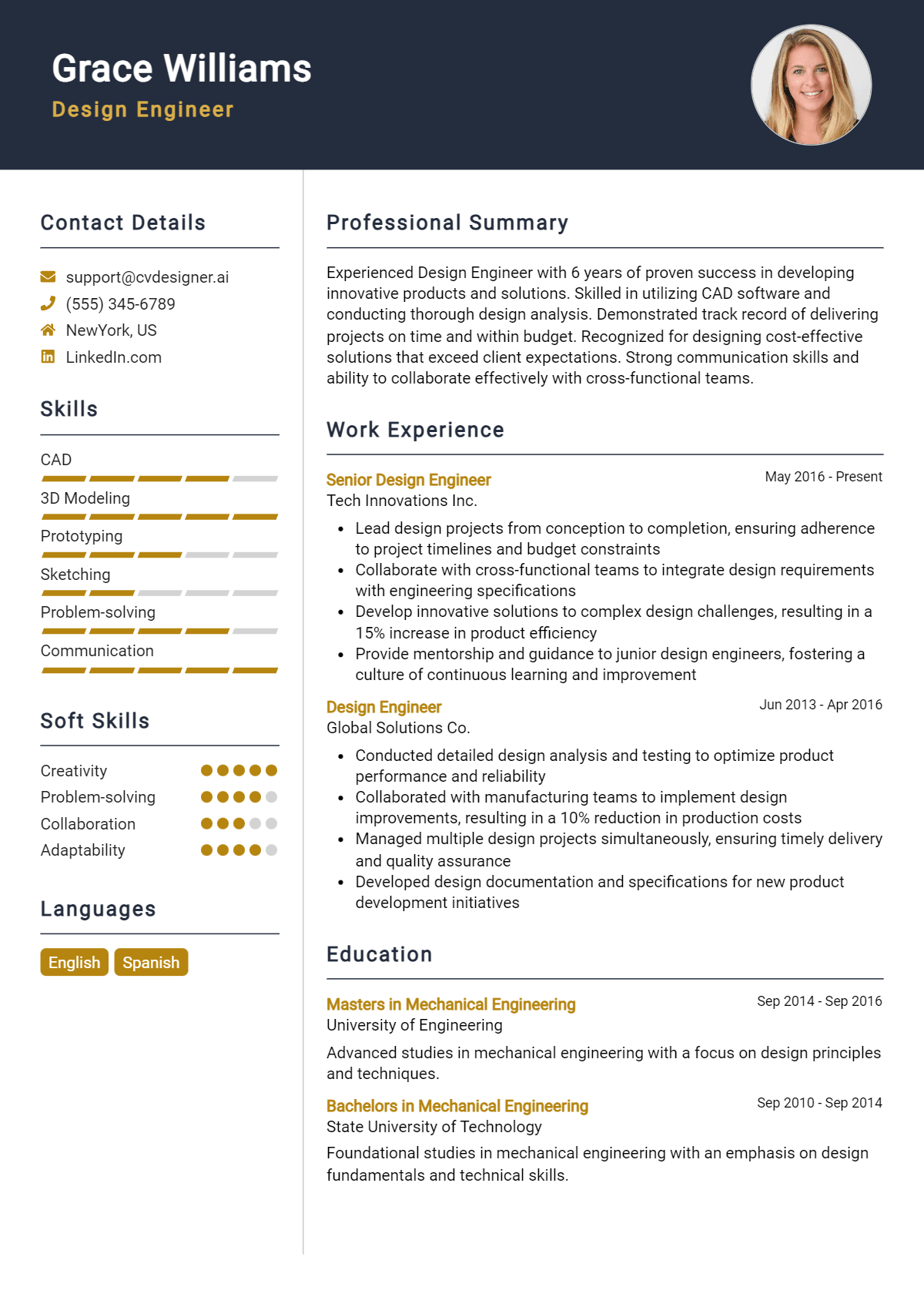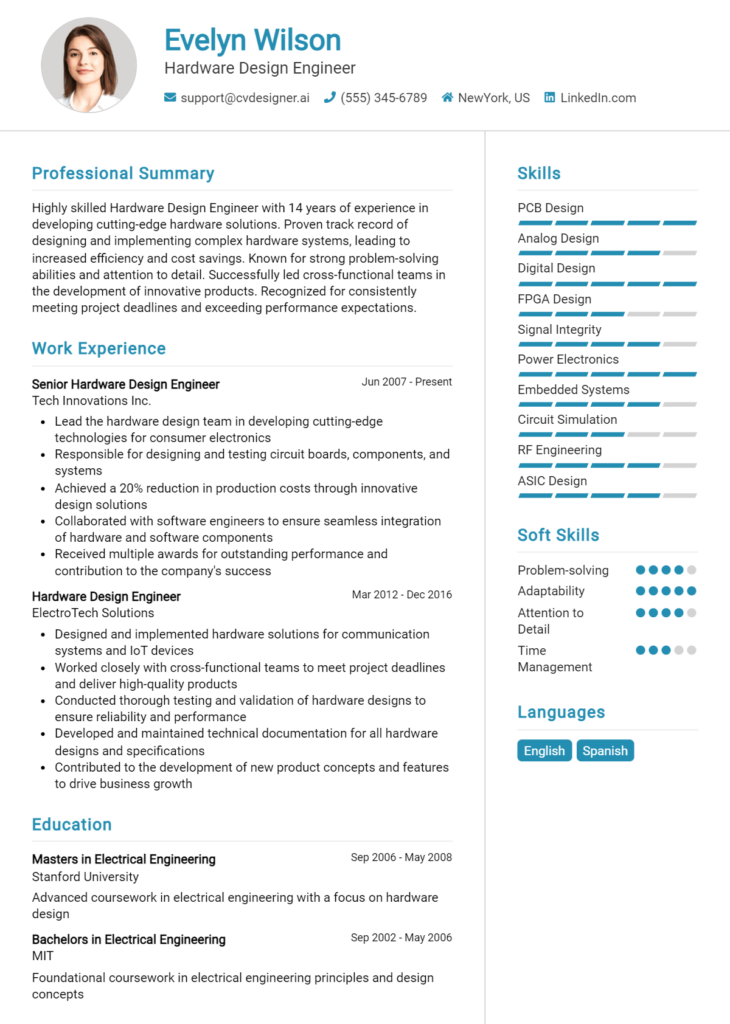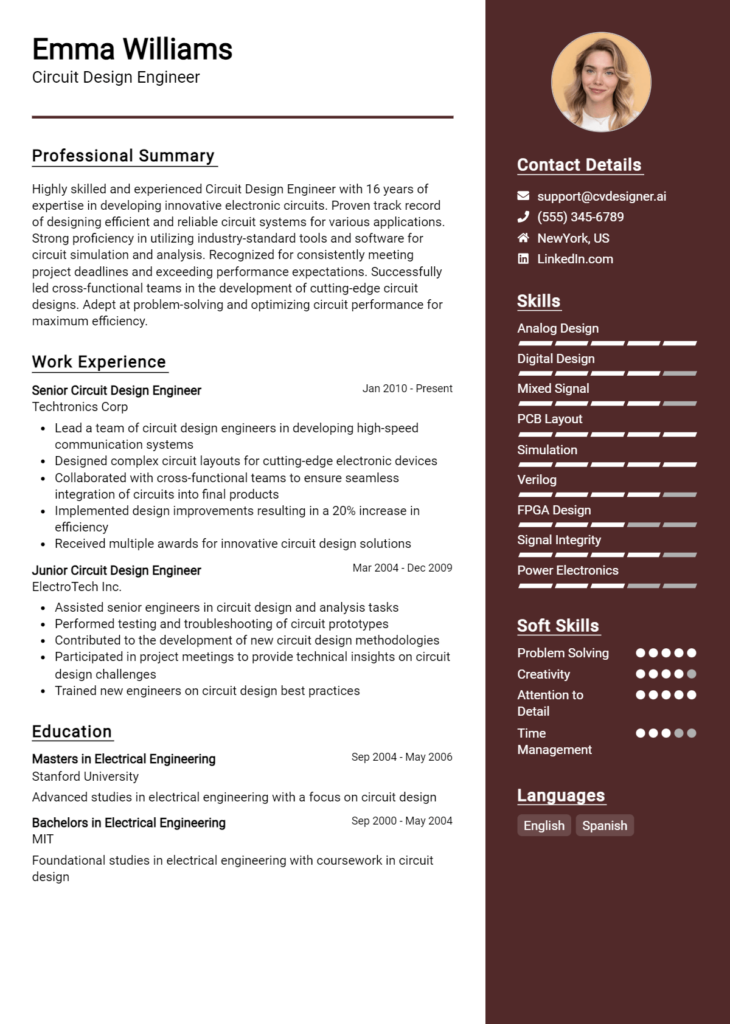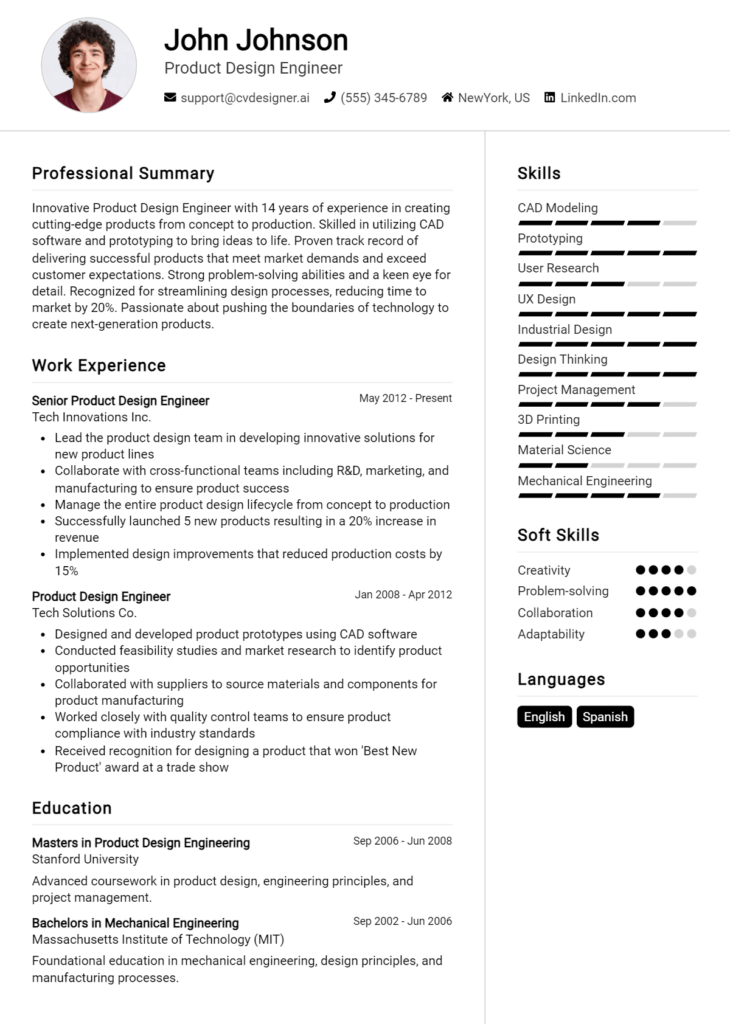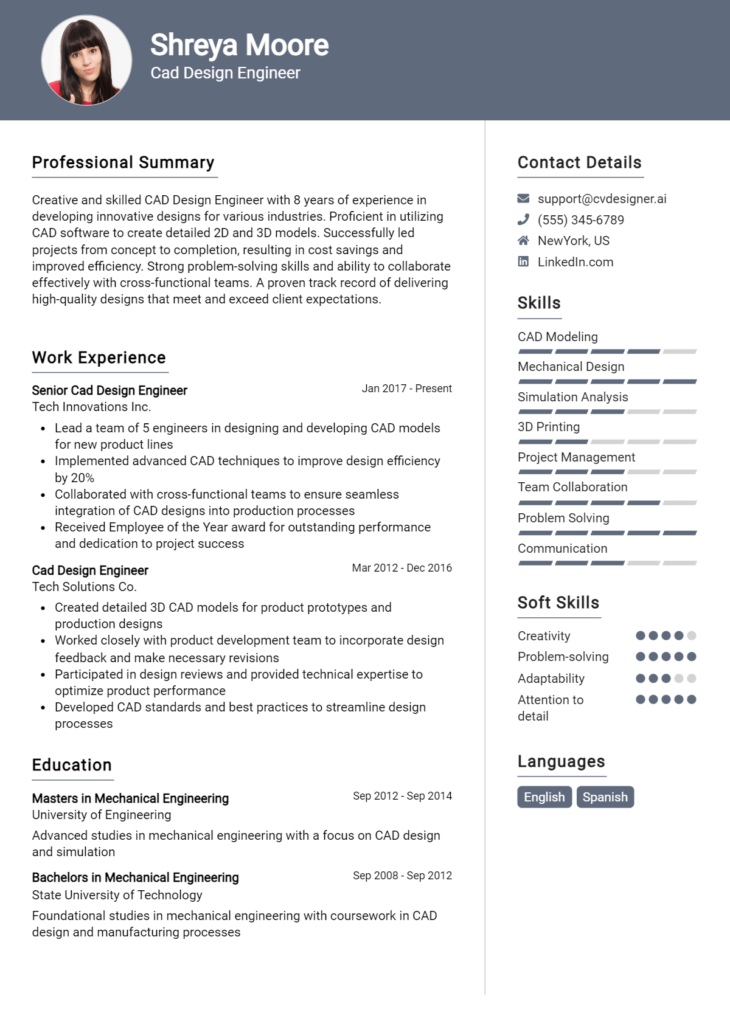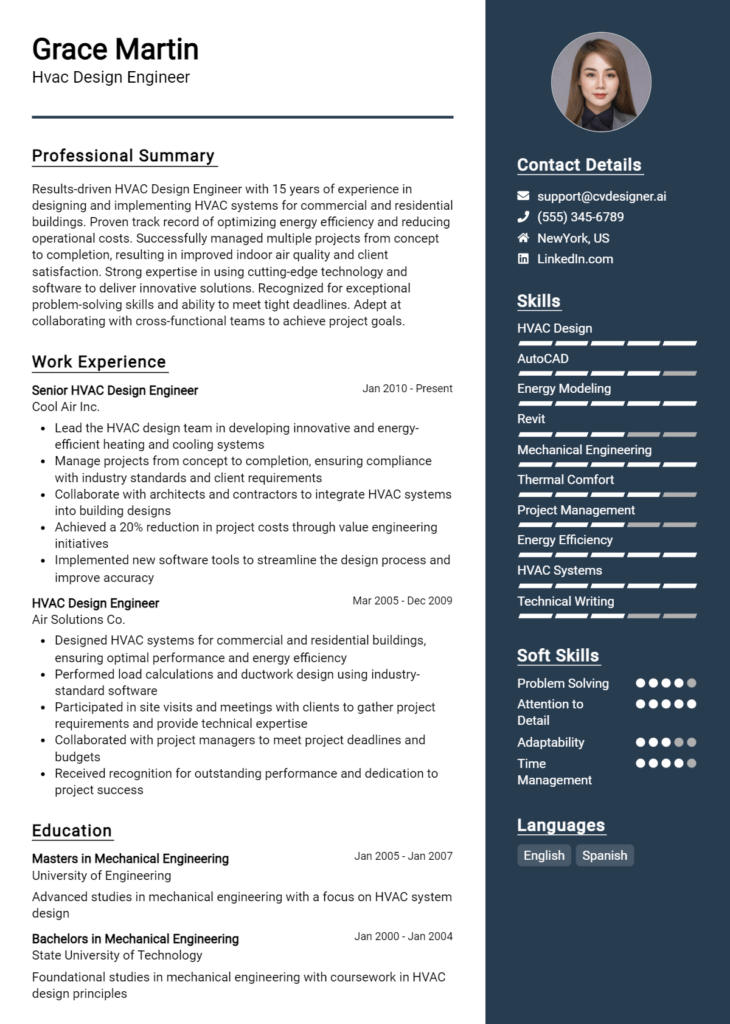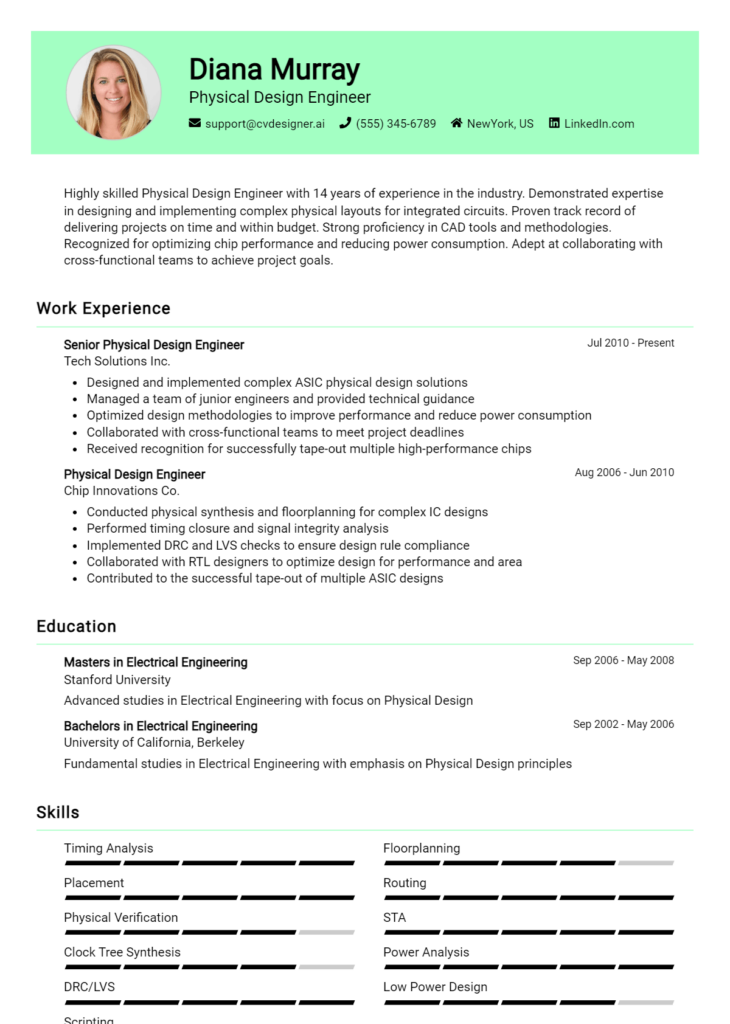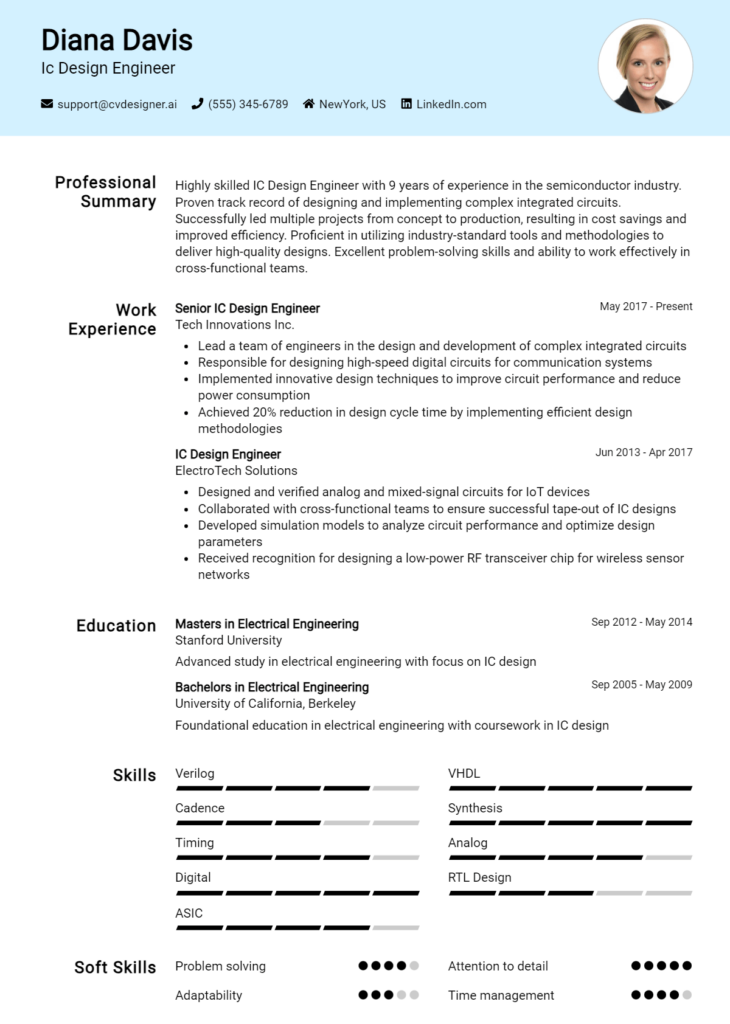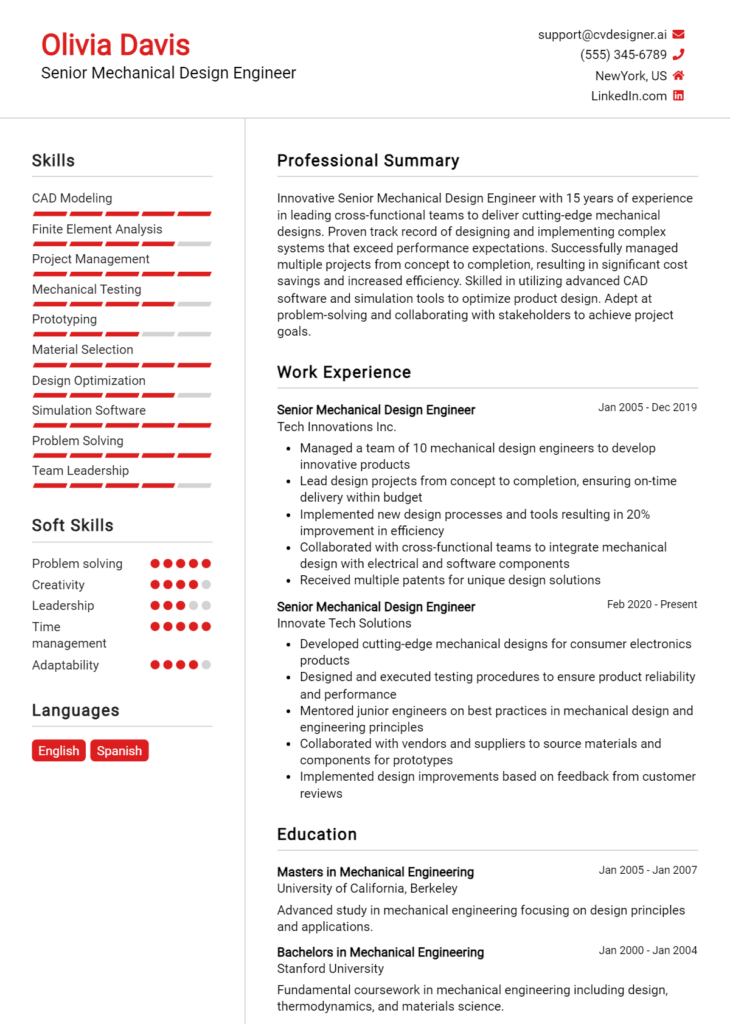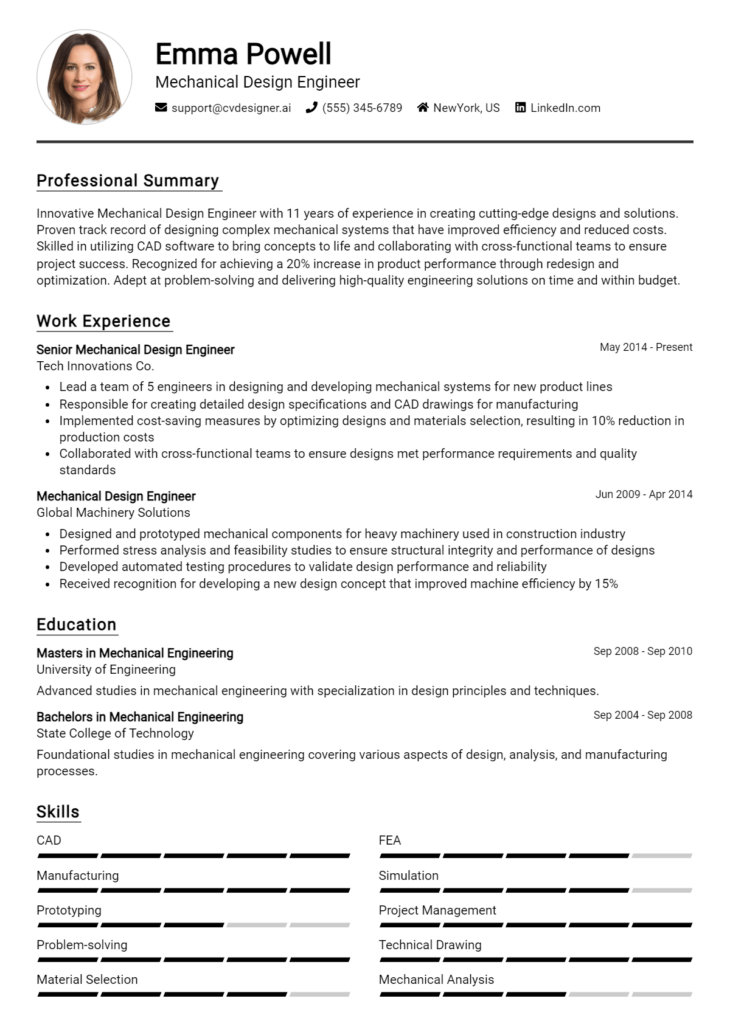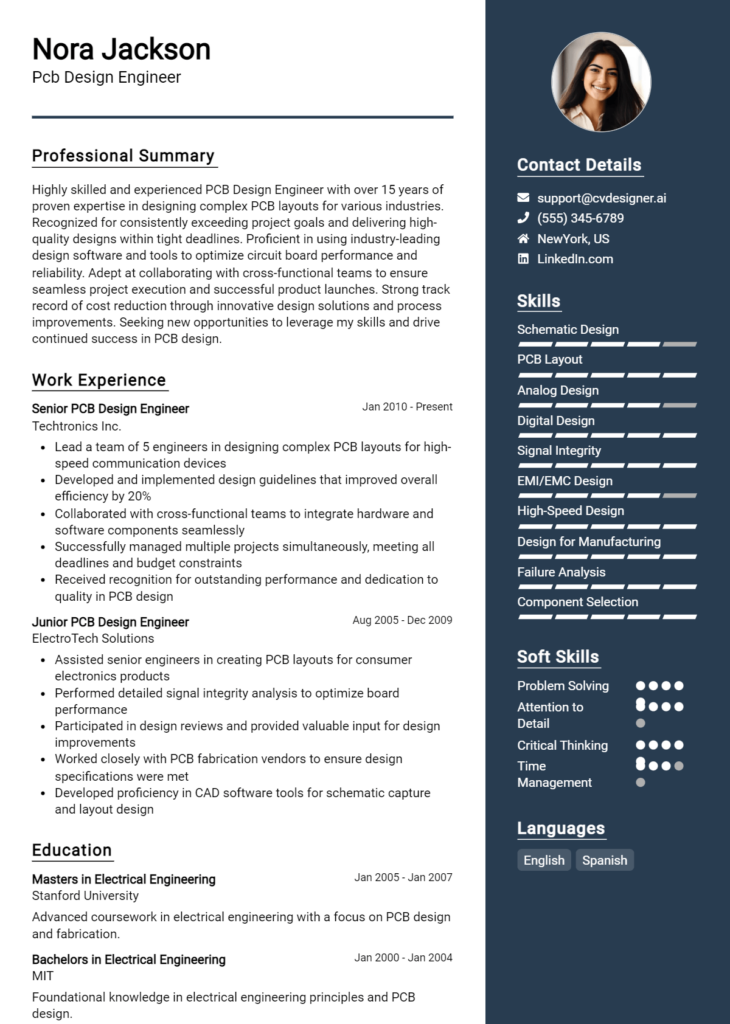Most Popular Design Engineer Resume Examples
Explore additional Design Engineer resume samples and guides and see what works for your level of experience or role.
As the backbone of innovation in various industries, design engineers are pivotal in transforming concepts into tangible products. Whether it's developing cutting-edge technology, creating sustainable solutions, or enhancing user experiences, the impact of a design engineer is profound and far-reaching. Crafting a compelling resume is essential for anyone looking to make their mark in this competitive field. A well-structured resume not only showcases your skills and experiences but also highlights your unique approach to problem-solving and creativity, which are crucial for a successful career in design engineering.
In this comprehensive guide to writing a design engineer resume, we will explore the core responsibilities and essential skills that define this role. You'll learn about the best resume formats to use and the common mistakes to avoid that could hinder your chances of landing that dream job. We will provide resume examples tailored for different experience levels, ensuring you find inspiration regardless of where you are in your career. Additionally, we will share invaluable tips on crafting your resume effectively, as well as guidance on selecting the right resume templates that will make your application stand out. Whether you are a seasoned professional or just starting, this guide will equip you with the tools necessary to create a resume that truly reflects your capabilities and aspirations in the design engineering field.
Key Responsibilities and Skills for a Design Engineer
A Design Engineer plays a crucial role in the development of products, from concept to completion. Their key responsibilities often include:
- Collaborating with cross-functional teams to define design requirements and specifications
- Creating detailed technical drawings and 3D models using CAD software
- Conducting feasibility studies and testing prototypes to ensure functionality and efficiency
- Analyzing design problems and providing innovative solutions
- Ensuring compliance with industry standards and regulations
- Documenting design processes and maintaining accurate records of revisions
- Communicating design concepts effectively to stakeholders and clients
Essential skills required for a Design Engineer include:
- Proficiency in CAD software (e.g., AutoCAD, SolidWorks)
- Strong analytical and problem-solving abilities
- Excellent communication and teamwork skills
- Attention to detail and a strong sense of aesthetics
- Project management skills to handle multiple tasks efficiently
- Knowledge of materials and manufacturing processes
- Familiarity with industry standards and regulations
Highlighting these skills effectively in the resume skills section is paramount. Tailoring them to the specific job description can significantly increase the chances of attracting the attention of hiring managers. Candidates should consider how these skills are relevant not only to the job at hand but also in creating a strong CV that showcases their qualifications and aligns with the needs of potential employers. By doing so, they can present themselves as well-rounded professionals who are adequately prepared for the challenges of the Design Engineer role.
Best Resume Format and Structure for a Design Engineer
When crafting a resume for a Design Engineer position, it's essential to choose a format that highlights your skills, experience, and education effectively. Here’s a detailed guide on the best resume format and structure for this role.
1. Contact Information
- Include your full name, phone number, email address, and LinkedIn profile (if applicable).
- You may also add your location (city and state) but avoid including your full address for privacy reasons.
2. Professional Summary
- Write a brief summary of your qualifications and career goals, typically 2-3 sentences long.
- Highlight your years of experience, key skills, and any notable achievements in design engineering.
- Tailor this section to the specific job you're applying for by using keywords from the job description.
3. Work Experience
- List your work experience in reverse chronological order (most recent job first).
- For each position, include your job title, the company name, location, and dates of employment.
- Use bullet points to describe your responsibilities and achievements, focusing on quantifiable results when possible (e.g., "Reduced design cycle time by 20% through process optimization").
- Highlight any specific engineering software or tools you used, such as CAD software.
4. Education
- Include your highest degree first, followed by any additional relevant degrees.
- Mention the name of the institution, degree obtained, and graduation date.
- If you have a notable GPA (usually 3.5 or higher), you might consider including that as well.
5. Skills
- Create a section dedicated to your technical skills relevant to design engineering.
- Include both hard skills (e.g., proficiency in SolidWorks, AutoCAD, MATLAB) and soft skills (e.g., problem-solving, teamwork, communication).
- Tailor this section to the job description by including skills that are specifically requested.
6. Certifications
- List any relevant certifications, such as Professional Engineer (PE) license, Certified SolidWorks Professional (CSWP), or Lean Six Sigma certification.
- Include the name of the certification, the issuing organization, and the date obtained.
Tips for Formatting:
- Use a clean, professional layout with consistent font sizes and styles.
- Choose a simple, modern font (e.g., Arial, Calibri, or Times New Roman) and maintain a font size of 10-12 points.
- Use headings to clearly separate sections and keep the resume to one page if you have less than 10 years of experience; otherwise, two pages can be acceptable.
- Utilize white space effectively to make the document easy to read and visually appealing.
Complementing Cover Letter Format The resume format you choose should complement your cover letter format. For a cohesive application, maintain the same header (name and contact information) on both documents. Use matching fonts and styles for consistency. In your cover letter, you can expand on the experiences listed in your resume, providing context and demonstrating your passion for the role. Tailor both documents to reflect the job description, emphasizing how your skills and experiences make you a strong candidate for the Design Engineer position.
Writing Tips and Best Practices for a Design Engineer Resume
When crafting a resume as a Design Engineer, it's essential to highlight your technical expertise and design skills in a clear and compelling manner. Tailor your resume to the specific job you are applying for by using relevant industry-specific keywords and phrases. This not only showcases your qualifications but also helps your resume get past Applicant Tracking Systems (ATS) that many companies use. Additionally, remember to showcase your achievements quantitatively, demonstrating the impact of your work through measurable results. The overall layout should be clean and professional, so utilizing resume writing tips can guide you in creating an aesthetically pleasing document. As you prepare your resume, consider how these practices can also enhance your cover letter.
- Use action verbs like "designed," "developed," "analyzed," and "implemented" to convey your contributions effectively.
- Quantify your achievements by including numbers, percentages, or other metrics to illustrate your impact (e.g., "reduced project costs by 15%").
- Incorporate industry-specific keywords to align your resume with the job description and demonstrate your familiarity with the field.
- Highlight relevant software and tools you are proficient in, such as CAD software or simulation programs.
- Keep your resume concise, ideally one page, while ensuring it covers all essential information without overwhelming the reader.
- Tailor your resume for each application, emphasizing the skills and experiences that are most relevant to the specific position.
- Use bullet points for clarity and easy readability, making it easier for hiring managers to scan your qualifications quickly.
- Include a summary statement that encapsulates your professional background and key skills, creating a strong first impression.
Common Mistakes to Avoid in a Design Engineer Resume
When crafting a resume for a Design Engineer position, it's crucial to present a clear and compelling overview of your skills and experiences. However, many candidates make common mistakes that can undermine their chances of securing an interview. By avoiding these pitfalls, you can enhance the effectiveness of your resume and create a stronger impression on potential employers. Here are some of the most frequent errors to steer clear of:
- Overloading your resume with excessive information, making it difficult to read.
- Using generic job descriptions that fail to highlight your specific contributions and achievements.
- Neglecting to tailor your resume for the specific job you are applying for.
- Failing to include measurable results or outcomes from your previous projects.
- Using inconsistent formatting, which can distract from the content.
- Omitting relevant technical skills or software proficiencies that are essential in the design engineering field.
- Listing responsibilities rather than emphasizing accomplishments and impact.
- Ignoring the importance of a concise summary or objective statement.
- Using jargon or technical terms that may not be familiar to all hiring managers.
- Neglecting to proofread for grammatical errors and typos, which can create an unprofessional impression.
To further enhance your application materials, consider reviewing common mistakes to avoid in a resume and ensuring that your cover letter is also polished by avoiding common cover letter mistakes. Taking the time to refine these documents can significantly improve your chances of landing that coveted Design Engineer role.
Sample Design Engineer Resumes
A Design Engineer plays a crucial role in the development and execution of innovative designs across various industries. Whether you are an experienced professional, a recent graduate, or someone transitioning from another field, having a well-crafted resume is essential to showcase your skills and experiences effectively. Below are three sample resumes tailored to different levels of experience and career paths in design engineering.
Experienced Design Engineer Resume Sample
John Doe
123 Engineering Lane
City, State, ZIP
(123) 456-7890
john.doe@email.com
Professional Summary
Dynamic and detail-oriented Design Engineer with over 10 years of experience in product design, development, and testing. Proven track record of delivering innovative solutions and improving existing designs. Expertise in CAD software and a solid understanding of manufacturing processes. Adept at collaborating with cross-functional teams to achieve project goals.
Professional Experience
Senior Design Engineer
ABC Manufacturing, City, State
March 2015 - Present
- Led the design and development of a new line of consumer electronics, resulting in a 25% increase in market share.
- Collaborated with the engineering team to implement design changes that reduced production costs by 15%.
- Conducted rigorous testing and validation of prototypes to ensure compliance with industry standards.
Design Engineer
XYZ Innovations, City, State
June 2010 - March 2015
- Developed detailed 3D models and technical drawings for various mechanical components.
- Assisted in the design and implementation of a new automated assembly line, improving efficiency by 30%.
- Coordinated with suppliers to ensure quality materials were used in production.
Education
Bachelor of Science in Mechanical Engineering
University of Engineering, City, State
Graduated: May 2010
Skills
- Proficient in CAD software (SolidWorks, AutoCAD)
- Strong analytical and problem-solving skills
- Excellent communication and teamwork abilities
- Knowledge of manufacturing processes and materials
Entry-Level Design Engineer Resume Sample
Jane Smith
456 Design Ave
City, State, ZIP
(987) 654-3210
jane.smith@email.com
Professional Summary
Enthusiastic and ambitious recent graduate with a Bachelor’s degree in Mechanical Engineering. Skilled in CAD design and eager to apply theoretical knowledge in a practical setting. Strong problem-solving abilities and a keen eye for detail, looking to contribute to a forward-thinking engineering team.
Education
Bachelor of Science in Mechanical Engineering
University of Technology, City, State
Graduated: June 2023
Internship Experience
Design Engineering Intern
Tech Solutions, City, State
January 2023 - April 2023
- Assisted in the design and development of mechanical parts for automotive applications.
- Developed 3D models and technical documentation using SolidWorks.
- Collaborated with senior engineers to conduct tests and analyze results, contributing to project improvements.
Projects
- Senior Design Project: Led a team to design an eco-friendly bicycle, focusing on sustainable materials and manufacturing processes.
- CAD Model Development: Created detailed models and simulations for various mechanical systems as part of coursework.
Skills
- Proficient in SolidWorks and AutoCAD
- Strong communication and teamwork skills
- Basic knowledge of materials science and manufacturing processes
- Quick learner with a passion for engineering design
Career Changer Design Engineer Resume Sample
Michael Johnson
789 Transition Rd
City, State, ZIP
(555) 123-4567
michael.johnson@email.com
Professional Summary
Results-driven professional transitioning into design engineering with a background in architecture and project management. Possesses strong design skills, a creative mindset, and a solid understanding of engineering principles. Seeking to leverage transferable skills to contribute to innovative design projects.
Relevant Experience
Project Manager
Creative Builders, City, State
March 2018 - Present
- Managed design and construction projects, ensuring adherence to timelines and budgets.
- Collaborated with engineers and architects to create detailed project plans and specifications.
- Developed project presentations, showcasing design concepts and construction methods to stakeholders.
Architectural Designer
Design Associates, City, State
June 2015 - February 2018
- Developed architectural designs and plans for residential and commercial projects.
- Utilized CAD software to create detailed blueprints and models, enhancing project visualization.
- Conducted site visits to ensure design integrity and compliance with regulations.
Education
Bachelor of Science in Architecture
University of Design, City, State
Graduated: May 2015
Skills
- Proficient in AutoCAD and SketchUp
- Strong project management and organizational skills
- Excellent communication and presentation abilities
- Familiarity with engineering principles and practices
For more inspiration, explore additional resume templates that cater to various fields and experiences. To complete your job application package, consider reviewing corresponding cover letter examples that can help you stand out to potential employers.
Checklist for a Design Engineer Resume
- Proofread for Typos and Grammar: Carefully review your resume for any spelling or grammatical errors. Use tools like spell check and read aloud to catch mistakes.
- Check Formatting Consistency: Ensure that font sizes, styles, and bullet point formats are consistent throughout the document. This enhances readability and maintains a professional appearance.
- Tailor Your Resume to the Job Description: Customize your resume for each application by highlighting relevant skills, experiences, and projects that align with the specific job requirements.
- Highlight Key Skills: Make sure to include both technical and soft skills that are pertinent to the Design Engineer role, such as CAD software proficiency, project management, and teamwork abilities.
- Use Action Verbs: Start each bullet point with strong action verbs to convey your achievements effectively. For example, use words like “designed,” “developed,” “implemented,” or “optimized.”
- Quantify Achievements: Where possible, quantify your accomplishments with numbers to demonstrate your impact. For example, “Reduced production costs by 15% through design optimization.”
- Include Relevant Certifications: If you have any certifications related to design engineering, such as Six Sigma or CAD certifications, be sure to include them prominently.
- Keep It Concise: Aim for a clear and concise resume, ideally one page, unless you have extensive experience. Eliminate any unnecessary information that doesn't add value.
- Ask for Feedback: Before finalizing your resume, consider asking a colleague or mentor in the industry to review it. Fresh eyes can catch errors you might have missed.
- Utilize an AI Resume Builder: Consider using an AI resume builder to help ensure all elements are well-organized and professionally presented.
Remember, a similar checklist can also be followed when creating a CV or a cover letter.
Key Takeaways for a Design Engineer Resume Guide
As you embark on the journey of crafting a standout resume as a Design Engineer, remember that the key elements highlighted in this guide are essential for showcasing your skills and experiences effectively. Utilize the provided examples and tips to tailor your resume to the specific demands of the position you aspire to. To further enhance your application, consider downloading a professionally designed template from our resume templates or a suitable cover letter template. For a more personalized touch, you can also explore our user-friendly resume maker that simplifies the design process. Following these guidelines will not only help you create a compelling resume but will also assist you in developing an impressive CV and an engaging cover letter. Take the next step in your career by utilizing these resources and putting your best foot forward in the job market!
